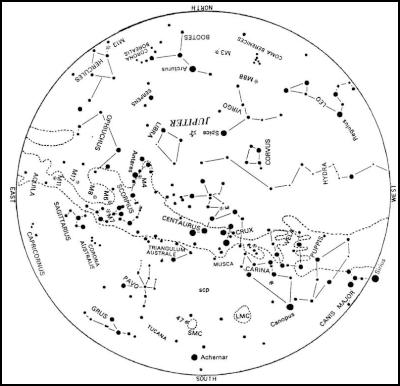The June Night Sky
The Night Sky
Brian Carter *Carter Observatory
The National Observatory Of New Zealand
THE JUNE NIGHT SKY
June is the month with the longest nights and shortest days.
Planets
June is a good month for observing the planets. All 5 major planets, Mercury, Venus, Mars, Jupiter and Saturn, are visible, although Mercury will not be visible for the first few days of the month.
Mercury will be visible in the Western evening sky for all but the first few days of June. By June 4 it sets at 18 01 (about an hour after Sunset), by June 25 at 18 55 and at 18 52 by month’s end. It starts the month in the constellation of Taurus, moving into Gemini on June 4, and finally into Cancer on June 26. During the month its magnitude rapidly fades from –0.9 to 1.4.
Mars will be visible for the first hour or so of the night. At the start of the month it sets at 20 27 and at 20 04 by month’s end. Mars is in the constellation of Cancer. Its magnitude slightly fades from 1.7 to 1.8 during the month.
Saturn will be visible for the first hour or so of the night. At the start of June it sets at 21 13 and at 19 34 by month’s end. Saturn is in the constellation of Cancer, in which it remains until September 2006. Its magnitude is a constant 0.4.
Jupiter will be visible for the first three quarters of the night. At the start of June it sets at 05 13 and at 03 10 by month’s end. Jupiter is in the constellation of Libra, in which it remains until December 2006. Its magnitude fades from –2.4 to –2.3 during the month.
Venus will be visible for the last hour or so of the night in the Eastern sky. At the start of the month it rises at 04 23 and at 05 22 by month’s end. Venus starts the month in the constellation of Pisces, moving into Aries on June 2 and finally into Taurus on June 19. During June its brilliant magnitude slightly fades from –4.0 to –3.9.
All times are for Wellington unless otherwise stated. Other centres may vary by a few minutes.
Phases of the Moon
First Quarter – June
4 at 11:06.
Full Moon – June 12 at 06:03.
Last Quarter
– June 19 at 02:08.
New Moon – June 26 at
04:05.
Winter Solstice
The Southern hemisphere Winter Solstice is at 00 26 on June 22. This is when the Sun is at its most Northerly point in the sky and therefore at its lowest altitude at the middle of the day in the Southern hemisphere. Mathematically this means that the longest night is June 21/22 and the shortest day is June 22. We say “mathematically”, as the nights and days are longer or shorter than the adjacent nights and days by only a few seconds, whereas actual Sunrise and Sunset times can vary by up to 3 or 4 minutes due to atmospheric conditions. This large variation means that any of the nights or days around the Solstice could actually be the longest or shortest.
Diary of Astronomical Phenomena
Jun
4 Moon at apogee (furthest from the Earth) at 14:00
(Distance = 0.0027011 AU = 404,080 km).
7 Spica is very
close to the Moon at 21 00.
12 Full Moon at 06 03.
17 Moon at perigee (closest to the Earth) at 05:00.
(Distance = 0.0024661 AU = 368,920 km).
18 Uranus
occulted by the Moon just before dawn (see note elsewhere in
Newsletter).
18 Mars close to Saturn in the
evening.
21 Mercury at greatest Easterly elongation from
the Sun (25) at 08:00.
22 Winter Solstice at
00:26.
26 New Moon at 04:05.
MAY SKY CHART
This chart shows the sky as it appears at about 21:00 for ~June 15.

Click for big version
How To Use the Sky
Charts
To use the sky chart hold it up to the sky so
that the direction in which you are looking is at the lower
edge of the map. For example, if you are looking at the
western horizon then the map should be held so that the
“WEST” label is at the lower edge. The altitude and
direction of the stars and planets will then be correctly
shown. The centre of the chart will be directly
overhead.
* Brian Carter is the Senior Astronomer at Carter Observatory (The National Observatory of New Zealand), PO Box 2909, Wellington. (Observatory Web Site: www.CarterObservatory.org)
ENDS


 Binoy Kampmark: The Australian Defence Formula, Spend! Spend! Spend!
Binoy Kampmark: The Australian Defence Formula, Spend! Spend! Spend! Ian Powell: New Hospital Building Trumps ‘Yes Minister’ Hospital Without Patients
Ian Powell: New Hospital Building Trumps ‘Yes Minister’ Hospital Without Patients Mike Treen: Prices Are Still Rising - It's A Cost Of Living Crisis
Mike Treen: Prices Are Still Rising - It's A Cost Of Living Crisis Gordon Campbell: On When Racism Comes Disguised As Anti-racism
Gordon Campbell: On When Racism Comes Disguised As Anti-racism Peter Dunne: Newshub And TVNZ Tip Of Media Iceberg
Peter Dunne: Newshub And TVNZ Tip Of Media Iceberg Harry Finch: Austerity – For And Against
Harry Finch: Austerity – For And Against